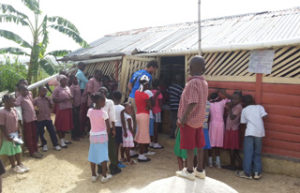By Anne Marie Amacher

For the past 12 years, ServeHAITI has worked to bring health care, child nutrition, clean water and education to Grand Bois, Haiti, and to show a commitment to sustainability. Continuing that mission this summer were parishioners of Our Lady of the River, LeClaire; St. Joseph, DeWitt; St. Paul the Apostle and Holy Family, both in Davenport; and from other parishes in Iowa and the Atlanta, Ga., area.
Gary Froeschle of DeWitt, a member of ServeHAITI, leads a committee formed to spur economic growth and to help Haitians become self-sufficient. The committee distributed an economic survey to the Haitian community to discover its vision and followed up with a series of entrepreneurship training classes. “This helps local residents learn how to research and create a viable business plan,” Froeschle said.
One of the trainees is Chantal, a single mother of one who moved back home to St. Pierre when her father fell and became paralyzed. Along with her sister, who is married with one child, Chantal operates a bakery that has been in the family for years. Froeschle said the women had been taught to bake by their father, who now uses a wheelchair and is unable to help with the bakery.
“Chantal has been making all the bread in the bakery by hand (in a wood-fired oven) and without a moulen (grinder) to roll the bread.” She attended the entrepreneur training in March 2012 taught by SHECON (ServeHAITI economics committee) and continues to attend meetings. That first training course brought 30 prospective entrepreneurs from the area, Froeschle said.
Through the program, Chantal would like to expand her bakery production. She plans to rebuild her oven for more efficiency and to acquire a machine that mechanically kneads the bread, allowing her to increase her output. “In addition, she has some innovative ideas for some different types of bread for the local markets,” he said.
After a year of planning and training, SHECON awarded two loans; one went to Chantal. The trip this summer “was eventful as I walked miles up and down the mountain to visit the entrepreneurs’ business sites. It was especially rewarding in that after all of the ground work and effort, we were actually able to make the loans,” Froeschle added.
In the education sector, educators Janet Green, Mary Froeschle and Lynn Leming worked with Haitian teachers.
“It has always been a goal of mine to go on a trip like this, but I wasn’t sure what my contribution would be,” said Green, who recently returned from her first trip to Haiti. When she learned she would train teachers, the uncertainty vanished. As a teacher for 30 years, she knows the importance of education in helping people to succeed.
Green said most Haitian teachers do not have a high school diploma, have no materials for their classroom and put up with classrooms with dirt floors that often hold 50 or more students. The Haitian teachers “were so thankful for the materials that ServeHAITI donated to the schools and really wanted to become better teachers.”
Teacher Kathleen Argo of Davenport traveled for the third time on the education mission to Haiti. “We brought books in Creole for the schools, along with medicine and dresses for other parts of the mission.”
During the day Green mentored Haitian teachers. “We are helping them become better teachers.”
This year’s group of teachers was new, Argo noted. In the past, the volunteers have worked with the same teachers to make sure they understood what was taught and to observe how they were implementing their knowledge in the classroom. Argo hopes to return.
Leming, also of Davenport, said the Creole teachers’ manuals provided the teachers with their first look at teaching objectives and new methods on instruction and strategies. “So much of our time was spent with them modeling through peer instruction. It was amazing how fast the teachers picked up on interactive ways to use simple materials.”
The educators also spent time each evening visiting families in the surrounding area. “I was touched by the simple lives they live and how hard they must work each day to feed their families,” Leming said.
During visits, she sees children and adults come to the water well outside the medical clinic. It’s a reminder to her that great need still exists in Haiti. “It’s what keeps me coming back.”
Abby Peeters, a college student who has been to Haiti before, worked on art with children from local schools. The first week they worked on drawing and painting projects in a school down the road from the ServeHAITI medical clinic, and provided an after-school program. “They don’t have opportunities like this very often,” Peeters said.
She also spent a few hours in the classroom with Haitian and American teachers doing teacher training.
Dr. Leo Bourgouin, physician for the Grand Bois clinic, kept Peeters busy with several art-related projects in and outside the clinic: painting signs on bathroom walls, ServeHAITI logos on the wells around the mountainside and other artwork.
“ServeHAITI’S goal for solidarity with the people of Grand Bois is also something to be appreciated. The organization has done so much to empower, teach and build relationships with the people of the area,” Peeters said.







